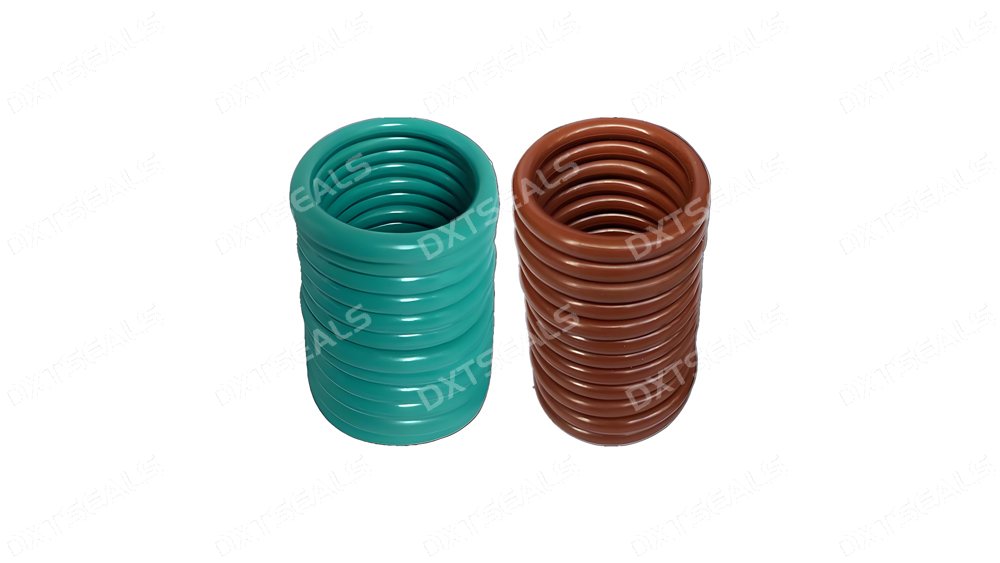
Rubber materials play a crucial role in industrial sealing, insulation, vibration absorption, and chemical resistance. Among the most commonly used rubber types are NBR (Nitrile Butadiene Rubber), FKM (Fluoroelastomer), and EPDM (Ethylene Propylene Diene Monomer). Each has unique physical and chemical properties that make it suitable for specific working environments.
In this article, DXTSEALS explores the key differences between these three rubber materials to help you make the right selection for your application.
🔍 At a Glance: Rubber Material Property Comparison
| Property | NBR | FKM (Viton®) | EPDM |
|---|---|---|---|
| Temperature Range | -40°C to +120°C | -25°C to +250°C | -50°C to +150°C |
| Oil & Fuel Resistance | Excellent | Superior | Poor |
| Chemical Resistance | Moderate | Excellent | Good (except petroleum) |
| Weather & UV Resistance | Poor | Good | Excellent |
| Abrasion Resistance | Good | Moderate | Moderate |
| Cost | Low | High | Moderate |
🔹 NBR – Oil-Resistant and Budget-Friendly
NBR is widely used in applications where oil, fuel, and hydraulic fluid resistance is essential. Its affordability and ease of processing make it a go-to material in automotive and industrial sectors.
✔ Advantages:
-
Excellent resistance to petroleum-based oils and fuels
-
Strong mechanical properties
-
Economical
✖ Limitations:
-
Poor ozone, UV, and weather resistance
-
Not suitable for high-temperature applications
Common Uses:
Oil seals, fuel hoses, O-rings, hydraulic seals, engine gaskets
🔹 FKM – Superior Chemical and Heat Resistance
FKM (e.g., Viton®) is a high-performance rubber designed for harsh environments. It maintains elasticity under high temperatures and offers excellent chemical resistance.
✔ Advantages:
-
Outstanding resistance to high temperatures and aggressive chemicals
-
Long-term durability in oil, fuel, and solvent-rich environments
-
Good aging and ozone resistance
✖ Limitations:
-
Higher cost
-
Reduced flexibility at low temperatures
Common Uses:
Aerospace seals, automotive engine components, chemical processing gaskets, high-temp O-rings
🔹 EPDM – Best for Weather and Steam Applications
EPDM rubber is best known for its resistance to outdoor weathering, UV rays, and steam. It is ideal for applications involving water, brake fluids, or outdoor exposure.
✔ Advantages:
-
Excellent resistance to weather, ozone, and UV
-
Great for steam and hot water applications
-
Maintains flexibility in low temperatures
✖ Limitations:
-
Poor resistance to oils, fuels, and hydrocarbons
Common Uses:
Roofing systems, water sealing, brake systems, HVAC gaskets, electrical insulation
🛠 How to Choose the Right Rubber Material?
When selecting a rubber compound, consider the following:
-
Oil or fuel exposure? → Choose NBR or FKM
-
Extreme temperatures? → Go with FKM
-
Outdoor or water application? → EPDM is the best fit
-
Budget constraints? → NBR offers solid performance at low cost
🔧 DXTSEALS: Reliable Custom Rubber Solutions
At DXTSEALS, we offer precision-engineered sealing solutions using NBR, FKM, and EPDM to meet demanding application requirements. Whether you need off-the-shelf or custom-molded parts, we ensure:
-
Accurate material selection
-
Fast delivery
-
Consistent quality and durability
✅ Conclusion
There’s no one-size-fits-all when it comes to rubber materials. Understanding the strengths and limitations of NBR, FKM, and EPDM helps you select the right solution for your project. Make informed decisions to improve reliability, reduce maintenance, and optimize performance.
📩 Contact DXTSEALS today for expert advice or to request a custom quote.
